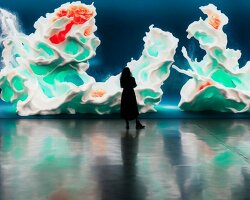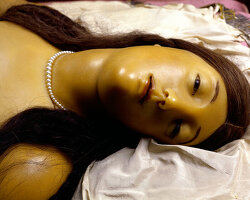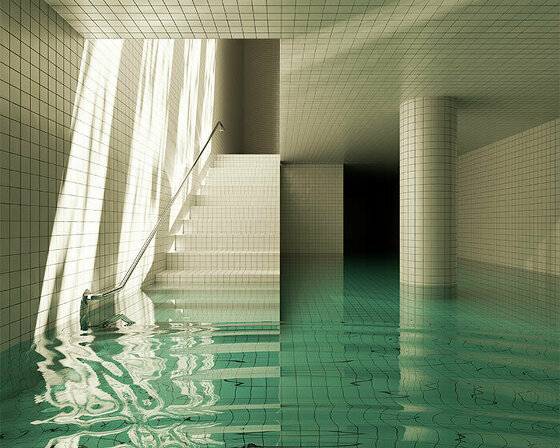70 Folding Screens inside fondazione prada Milan
Documenting the decades-old tradition and the shifting morphology of paravents takes center stage at ‘Paraventi: Folding Screens from the 17th to 21st Centuries’ at Fondazione Prada in Milan. designboom spoke with the exhibition’s curator, Nicholas Cullinan, who is also the Director of the National Portrait Gallery in London. Before that, we roamed around the ground and first floors of the Podium, the spaces that architectural firm SANAA designed for Fondazione Prada’s exhibition and where seventy folding screens are on display. The Podium’s ground floor features curved, transparent Plexiglas, forming a bubble that surrounds the history and modern folding screens. Gray, wavy curtains complement the appearance of the Plexiglas, a decision made by SANAA, Nicholas Cullinan, and the curation team to guide visitors into a labyrinth comprising folding screens from the 17th to the 21st centuries.
‘Paraventi: Folding Screens from the 17th to 21st Centuries,’ which runs from October 26, 2023, to February 22, 2024, coincides with two complementary shows organized by Prada. One is at Prada Rong Zhai in Shanghai, and the other is at Prada Aoyama Tokyo in Japan. These three shows continue the effort to document and investigate the historical lineage of historical and contemporary folding screens in both Eastern and Western contexts. On the ground floor of the Fondazione Prada in Milan, Chinese and Japanese screens depict naval battles and aerial views, juxtaposed with modern folding screens that resemble a colossal cheese grater and a series of bookshelves turned full-body scanners at the airport and vice-versa. It is also here that projected films on cloth-cloaked wooden frames play movies featuring Japanese landscapes and a human wearing bunny ears.

images courtesy of Fondazione Prada | photos by Delfino Sisto Legnani and Alessandro Saletta – DSL Studio (unless stated)
In another space, worn jeans hang on folding screens, foldable smartphones display psychedelic wallpapers that hypnotize viewers, and Art Nouveau deities announce their presence in the exhibition through vintage folding screens. Walking up to the first floor, barriers are canceled out, replaced by a pathless labyrinth with folding screens by Pablo Picasso, Alvar Aalto, Charles and Ray Eames, and Le Corbusier, to name a few. Almost an infinite number of paraventi block out other visitors from view or momentarily hide them behind, which may be one of the reasons these products of art, design, and architecture exist. Nicholas Cullinan shares more about the history and context of the folding screens in his interview with designboom. He delves into how the exhibition came about, the premise of the labyrinth layout of the spaces with SANAA, and the techniques that have been passed down from one generation to another in the making of folding screens. Read on to learn more.

image © designboom | Cao Fei, Screen Autobiography (Milan), 2023. Xiaomi MIX Fold 3 and Lenovo ThinkPad X1 Fold
Interview with Nicholas Cullinan on folding screens exhibition
designboom (DB): Can you tell us why did this inquiry on the history of paravents happen?
Nicholas Cullinan (NC): I’ve worked with Fondazione Prada for over 12 years now, and they have been thinking about this topic and researching it for some time. We were discussing another project and what we could do, and then they asked me if I would be interested in paravents. They sent this incredible document of all the screens they’ve found, and it blew my mind. We all know about folding screens, and maybe you can think of a handful of artists or architects who have made them, but this was a whole history that hasn’t been put together or told before. I have great respect for the work the foundation is doing, which I find unique, especially in Italy. My background is in post-war Italian art, and that’s what I did my PhD in. That’s how I met Ms. Prada. I’m very supportive of what the foundation does, and I think they’re doing an amazing job. Their program and ideas are quite unique and different from other mediums.
DB: And how do you feel about being entrusted with this significant exhibition to curate?
NC: Well, it’s an honor, a privilege. I was aware right away that it would have to be a collective effort or a team because no one person is going to be an expert on all of this material. The ambition from the beginning was to trace folding screens from their beginnings in Asia, China, Japan, etc., and then their journey to Europe and how European and Western artists began to adopt them, particularly in the 19th and 21st centuries. I can’t think of one person who could be an expert in all of these areas. I’m certainly not. So it was important to include a variety of voices. About the catalog that we have for the exhibition, the team did incredible research and we commissioned scholars from different perspectives and with varying expertise that I don’t have. It’s very important to have that reflected and also working with in terms of how this could physically unfold. It was very clear that it couldn’t just be one person’s voice; although in a way I’m putting forward these arguments, there are many other perspectives and voices in there as well, which is necessary.

Exhibition view of Paraventi: Folding Screens from the 17th to 21st Centuries’
DB: For this exhibition, the curation team commissioned seventeen different artists to devise their own folding screens. As a curator, how did you confront simultaneously working with different artists and were they given a leeway to experiment with the brief or was there an established brief that they needed to follow?
NC: It was pretty open. We commissioned artists who hadn’t made a folding screen yet to keep the exhibition alive in the present and not just a historical survey but to show its ongoing and generative nature. We approached artists who we thought might be interested and whose practice aligned with the concept. What was wonderful is that often, the artists themselves said, “I’ve been interested in folding screens, and I’ve always wanted to make one.” For example, John Stezaker mentioned seeing an exhibition in the early ’80s that had a big impact on him, and since then, he wanted to make a folding screen.
We carefully considered the artists we asked. Some of them have longstanding relationships with Fondazione Prada, which is unique and important. The foundation maintains these enduring connections, and this is quite special. There are artists that have a history with the foundation, and there are also artists that have never worked with the foundation. It’s about bringing in new voices and collaborations. The brief itself was intentionally open, with a simple instruction to create a folding screen, not bigger than X, not smaller than Y, and see what ideas emerged.
DB: There’s even a giant cheese grater looking in the show!
NC: So that’s Grater Divide by Mona Hatoum, and that it’s not a commission but actually an existing work. There’s a play on a cheese grater, but also a lot of her work is humor and almost surrealist use of an object that’s been appropriated and quite a different context here but scaled up. There’s a nuance of violence to it and a threat as well. It’s a great piece.

inside Fondazione Prada Milan’s folding screens exhibition
DB: Did you notice some continual themes that throughout history have been passed on when it comes to the paravents techniques?
NC: That’s interesting. I mean, obviously, this spans centuries, continents, and cultures, so there are many differences, which is important to acknowledge. But there are some constants. One thing is, why make a screen in the first place or have a folding screen? There are practical aspects like demarcating space, providing privacy, and shielding against drafts, especially in the domestic sphere. For many artists, they’re drawn to the multi-part nature of it. It’s not just the fact that it’s a political tool, which is another intriguing history. The relationship between folding screens and politics is complicated and beyond the scope of this commission. There’s also the idea of different vantage points. Many artists, from the origins of folding screens in Asian contexts, use them to depict the seasons. They play with these vantage points to show spring, summer, autumn, and winter. So, the structure itself becomes an interesting vessel for different narratives and perspectives.

SANAA designed for Fondazione Prada’s exhibition which features curved, transparent Plexiglas
DB: We’ve established that by now you worked with SANAA to create the exhibition phase. Can you tell us a little bit more about the premise of the layout and how can the visitors fully exploreand understand the visitors?
NC: I know the space well from having worked before on the advisory group for the Fondazione Prada in Milan when it opened. I knew the threads I wanted to work with, and that’s this amazing space of the podium, both upstairs and downstairs. Downstairs you have these glass walls, and as much as possible I wanted to keep those walls open. I remember in the very early meetings, whatever I did, I wanted the ground floor open and then for the first floor to be very different because otherwise, I thought you would just have 70 folding screens at once, one after another.
The challenge was to draw out the differences rather than to have a lot of similar things, and so I knew that whatever I did, I wanted them to be very different and almost on opposite ends of the spectrum. I remember the early days thing that maybe downstairs was more like structures; more like a peep show or a study of privacy. More circular, and maybe more like a warehouse with no walls. That’s how it happened. We worked with SANAA to hone that and to work with their use of materials to bring in transparency and then upstairs for all of us to do as little intervention as possible, curatorially and architecturally, and to let the screens be the structure and the argument themselves.

Fondazione Prada Milan’s folding screens exhibition
DB: Were there any challenges faced during the curation of this exhibition?
NC: In terms of the layout, it was how to get the right levels to show these. We had to bring in curtains and judge everything very finely where it was placed. Another big thing about the show, I think it’s not just about how the individual works as shown, but often about the relationship or the shifting vantage points between them. As you walk around them, some of them are similar, and one-sided, but you have this relationship shifting.
Then, it was more about using the space to maximum effect up there using the fact that there are no windows, it’s one big space. I didn’t want to divide it, I wanted to keep it open. It’s trying to make the most of the inherent qualities of the building and then using that to make the most of the work themselves and the story that you’re trying to tell and the different chapters and different arguments. And that’s why, for example, the transparent ones are on the perimeter next to the window, so there’s double transparency.

Fondazione Prada Milan’s folding screens exhibition view
DB: Do you have any words of wisdom for aspiring curator who want to curate an exhibition that’s heavily based on extensive and significant research?
NC: Research is fundamental whether you’re doing a historical project, a big survey, or a monographic exhibition or a contemporary show. There’s always a very important level of research that goes in. The question of how that manifests itself depends on the topic, theme, or context. You can have scholars for example, the catalog for this exhibition have amazing writers, and it’s very rigorous, but the physical exhibition is related or similar, but different things at the same time. For me, that’s the research part.
Then you have to think at the same time about physical time and space. How is that story going to work? Otherwise, it’s a book in a room. I think you have to always think about how can you make the physical experience of walking between objects through time and space as enjoyable as possible, as enlightening as possible and balancing those two things. Of course you increase, but what you don’t want to do is just make a show that’s very didactic or heavy or boring. It’s almost two sides of the same coin, which is the rigorous scholarship, but also being able to turn that into something enjoyable, beautiful, or memorable.

image © designboom

Fondazione Prada Milan’s folding screens exhibition



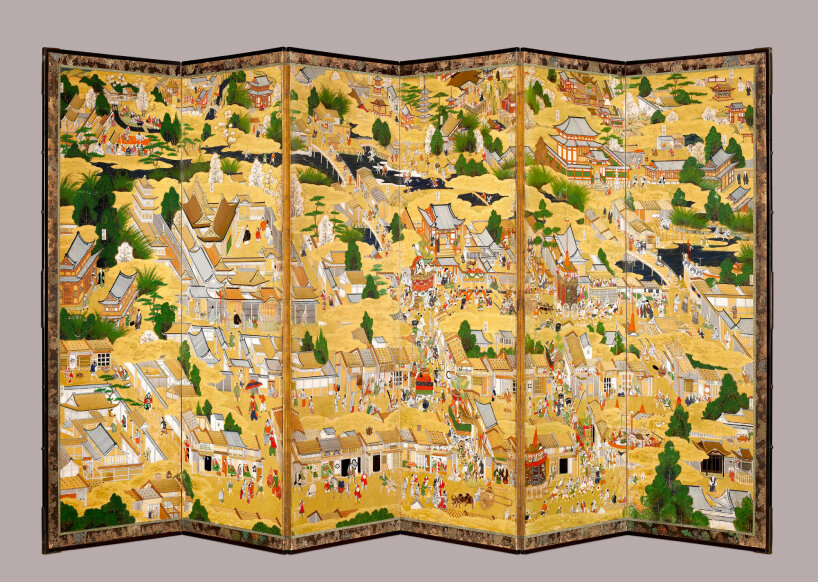

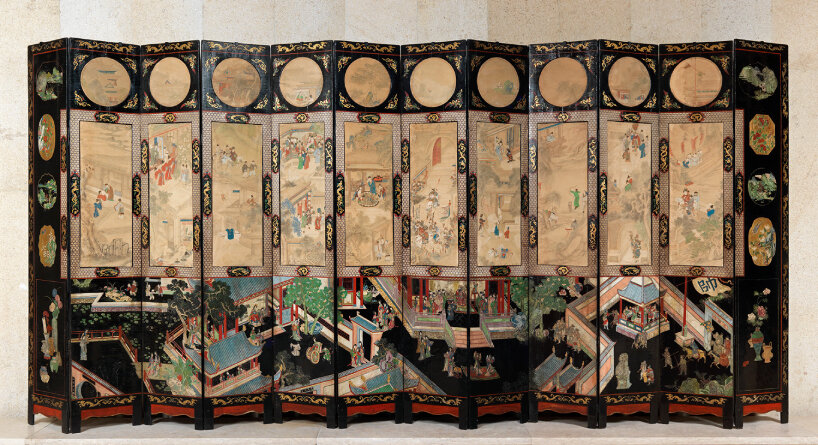
project info:
name: Paraventi: Folding Screens from the 17th to 21st Centuries
exhibition design: SANAA
exhibition curator: Nicholas Cullinan
exhibition space: Fondazione Prada, Milan
location: Largo Isarco, 2 in Milan
dates: October 26th, 2023 and February 22nd, 2024
ART INTERVIEWS (119)
EXHIBITION DESIGN (527)
FONDAZIONE PRADA (38)
PRODUCT LIBRARY
a diverse digital database that acts as a valuable guide in gaining insight and information about a product directly from the manufacturer, and serves as a rich reference point in developing a project or scheme.






